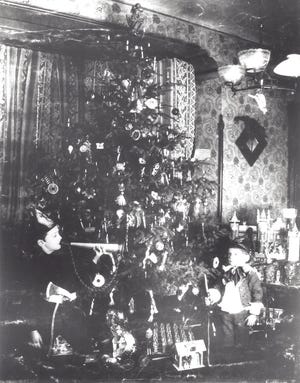

You've heard the dilemma before.
It's the week of Thanksgiving yet Christmas plans and celebrations have somehow crept to the forefront. It's an etiquette question many families who celebrate Christmas face every year. And some have even fixed rules about how to navigate the season.
Rules such as: No Christmas music until after Thanksgiving, or no decorations until the beginning of December. Or for some families who exert massive willpower, no Christmas-related festivities until the winter solstice on Dec. 21.
But in historically German Catholic cities such as Cincinnati, the timeline is a bit more concrete. There's a day that exists between Thanksgiving and Christmas that serves as a start to the Christmas season and is often the first big celebration on the Advent Calendar.
The Feast of St. Nicholas, commonly known as St. Nick's Day, takes place annually on Dec. 6 and though it involves stockings and small gifts, it is separate from celebrations on Christmas Eve and Christmas Day.
It's popular in American cities with large German or Dutch populations such as Cincinnati, Milwaukee, Pittsburgh, St. Louis and Cleveland.
In Cincinnati, for instance, the German Heritage Museum will host the "St. Nikolaus Fest" from 1 to 5 p.m. Sunday at its West Fork Road location. German songs will be sung, candy canes will be given to children, and a nativity scene is set up to replicate how the holiday is celebrated in Germany.
The Enquirer spoke with Don Heinrich Tolzmann, curator of the German Heritage Museum and president of the German American Citizens' League to answer questions about how the Cincinnati area's mini Christmas before Christmas became a longstanding tradition.
Holiday beers 2021:Your guide to special seasonals in Greater Cincinnati
More:Downtown department stores were festive for holiday shopping
Who was St. Nicholas?
According to Tolzmann, St. Nicholas was a bishop during the Roman Empire who became the Patron Saint of Children because of the kindness he showed to young kids. He was widely known for gift-giving and for helping the poor even if it meant selling his own possessions.
When St. Nicholas left some golden coins behind for some children that slipped into a stocking that was hung up to dry, a long-lasting custom was born.

"That started the tradition of children hanging up stockings or leaving a boot or a plate out on St. Nicholas eve, which is on (Dec. 5)," Tolzmann said.
St. Nicholas was named a saint by the church on Dec. 6, which is the same day he is believed to have died in 343 A.D.
Dec. 6 is St. Nicholas's "Feast Day" as declared by the church, Tolzmann said.
Holiday lights:10 of the grandest Christmas displays in and around Cincinnati 🎄
Bucket list:Top 10 holiday events every Cincinnatian should attend at least once
When did St. Nick's Day become a celebration?
The Dec. 6 Feast of St. Nicholas became a popular tradition during the medieval period, particularly in Germany and German-speaking countries.
"If (children have) been good, St. Nicholas would leave fruit like an apple or an orange, chocolate, sweets and other goodies," Tolzmann said. "And if they haven't been good, they might find a lump of coal behind, or some switches (sticks) that parents could use to scold children."
When did St. Nick's Day come to America?
St. Nick's Day was brought to the United States with German immigration that began in the 1600s.
In Cincinnati, Dr. Ludwig "Louis" Rehfuss, a German immigrant who was a medical doctor, set up the first Christmas tree in the early 19th century, Tolzmann said. St. Nick's Day began in Cincinnati sometime around that same time period, he said.
"That custom, because of the German heritage of our area, is widely celebrated here even to this day," he said.

St. Nicholas vs. Santa Claus
On St. Nick's Eve, St. Nicholas fills stockings left out for children based on how they behaved that year.
On Christmas Eve, Santa Claus – sometimes referred to as St. Nick, Kris Kringle or Father Christmas – similarly fills stockings and gives presents to children based on their behavior.
According to Smithsonian magazine, a Bavarian immigrant named Thomas Nast who was a cartoonist during the Civil War, created the first image of Santa Claus in 1863. The image, which first appeared in Harper's Weekly, was created as Union propaganda during the war, featuring Santa handing out presents at a Union Army Camp. In the image, Santa wears a jacket that has stars and pants colored in stripes.
The image was based on the likeness of St. Nicholas.
"The popular image of Santa Claus goes back to St. Nicholas," Tolzmann said.
'A big part of Cincinnati's culture'
On Monday, many families in the area will celebrate the Feast of St. Nicholas, a tradition that has held on for nearly 200 years.
On the morning of St. Nicholas Day, children will wake up early and run downstairs to see what gifts they've received.
"You'll hear cries and shrieks of excitement," Tolzmann said. "It tells them 'Hey they have been rewarded with something, they have been good.' And so St. Nicholas rewarded them for being good."
Although Christmas Day receives all the buzz, St. Nick's Day is an important part of Cincinnati's culture, Tolzmann said.
"In the German heritage, the Christmas season is not just the celebration of Christmas Eve and Christmas Day, a two-day event, it's the whole advent season," he said. "St. Nicholas Day is a big part of Cincinnati's culture. It's a part of the way the Christmas season is celebrated."
Premature talk about Christmas in Cincinnati before Monday might be met with similar reactions to the one from Tolzmann.
"I can't imagine the Christmas season without the celebration of St. Nicholas Day," he said.
Source link









